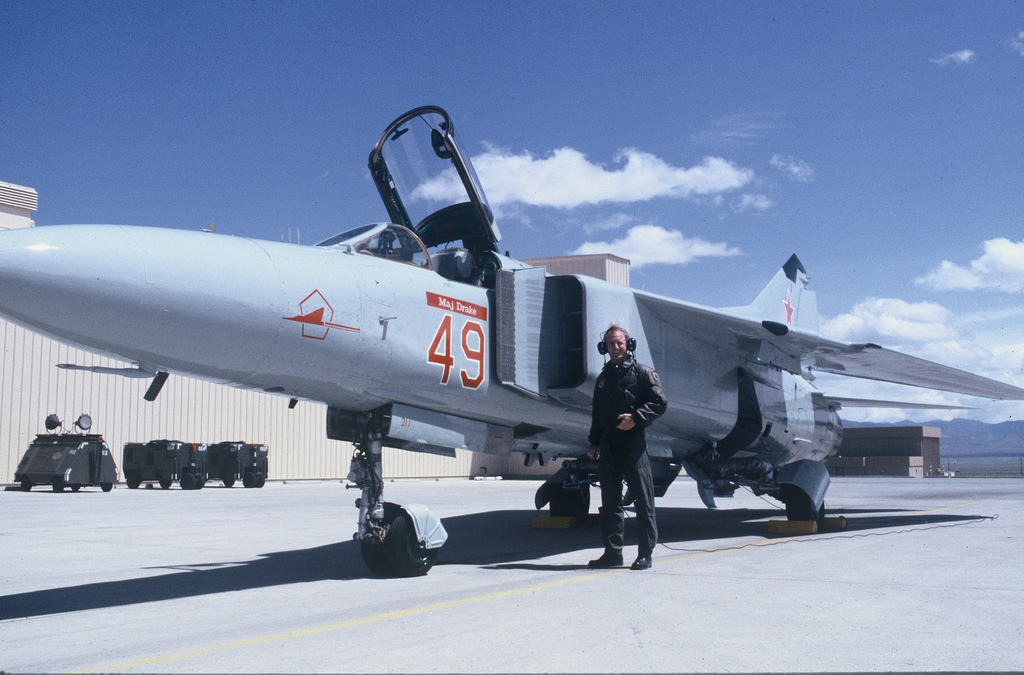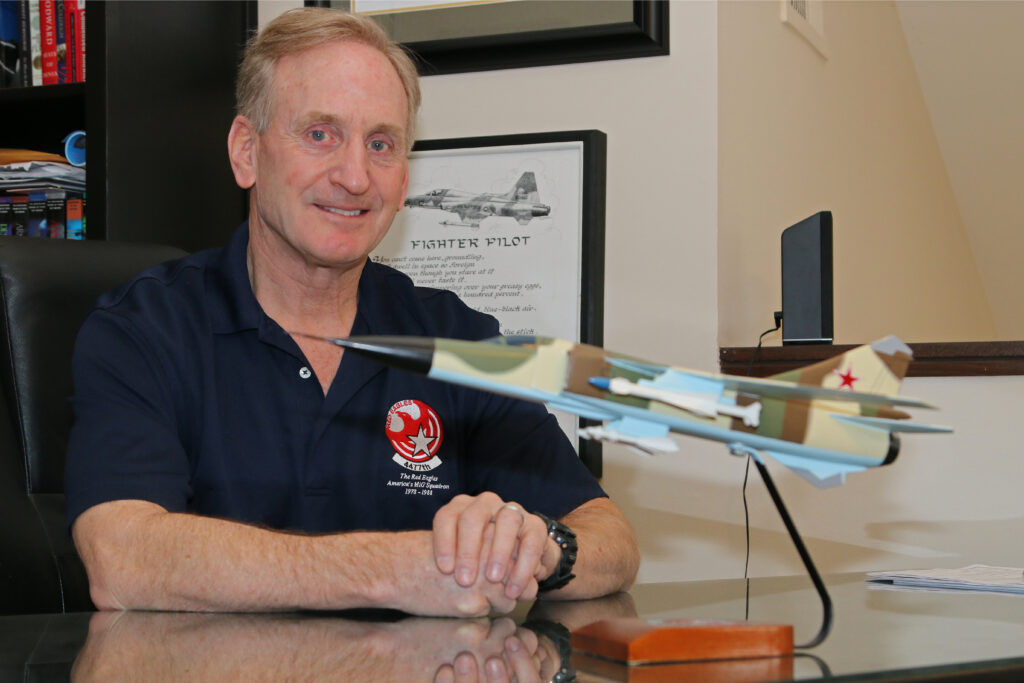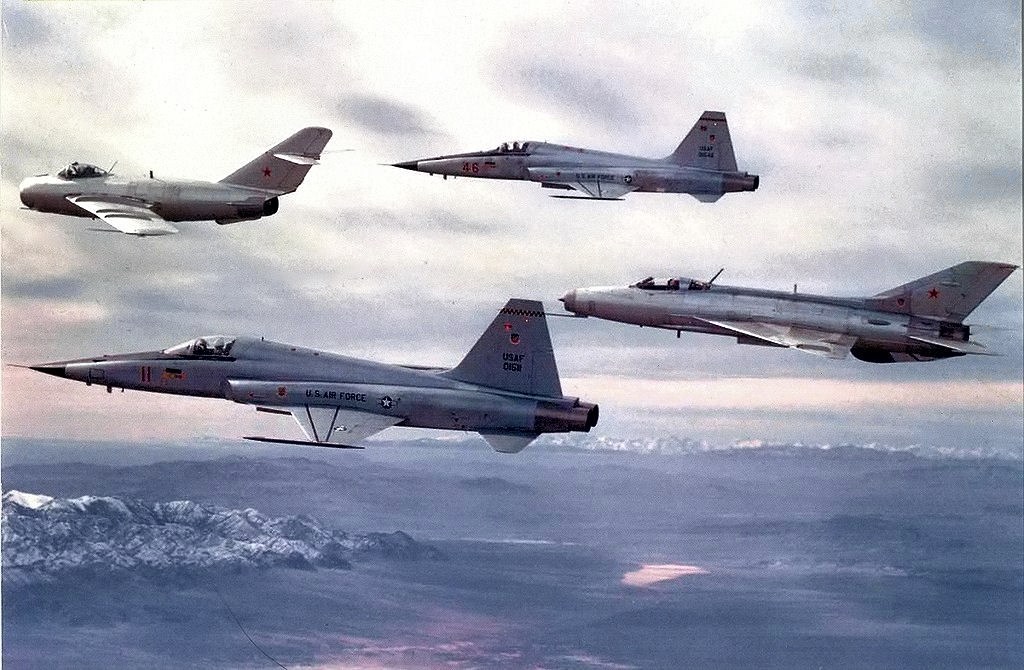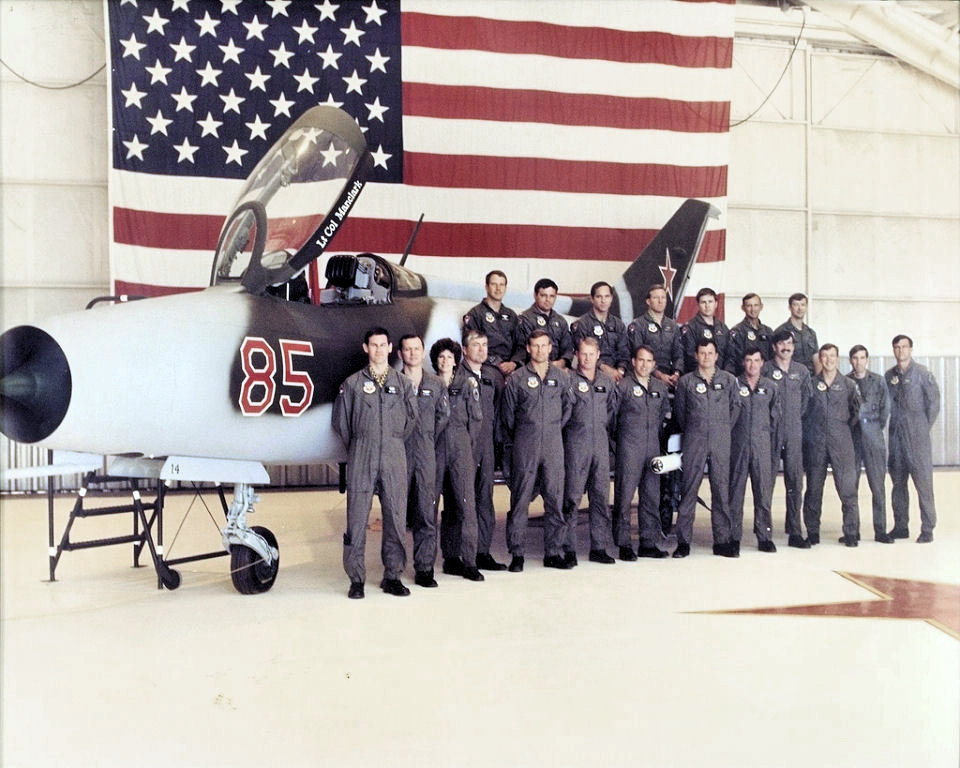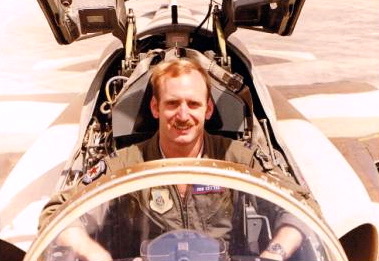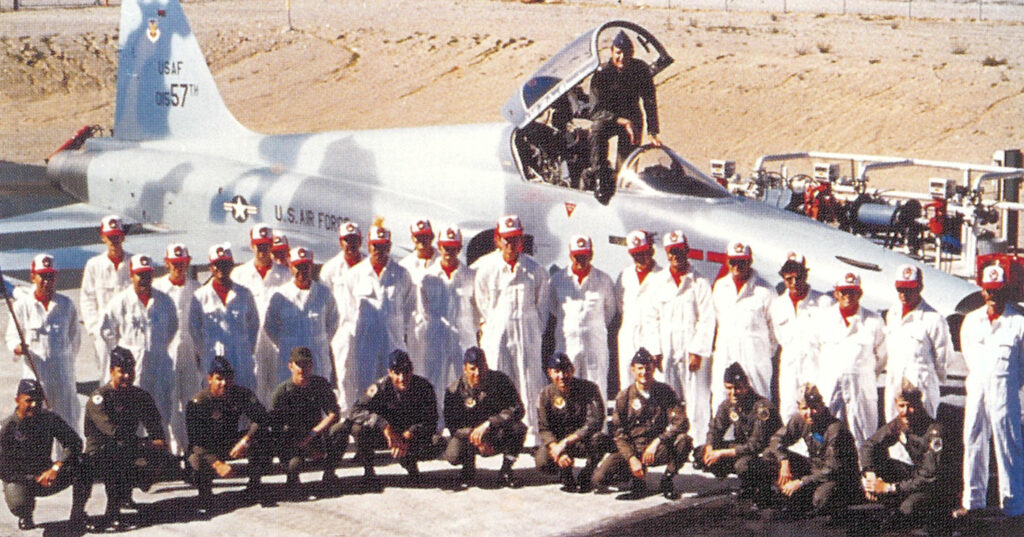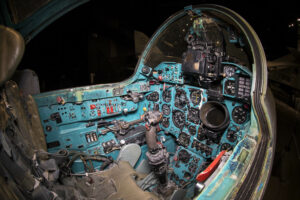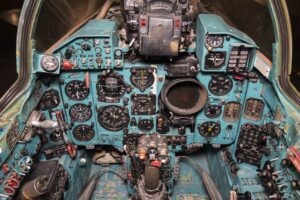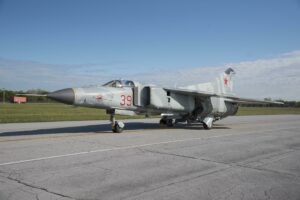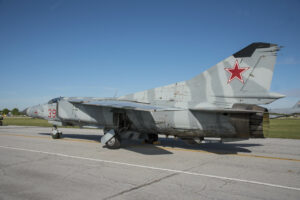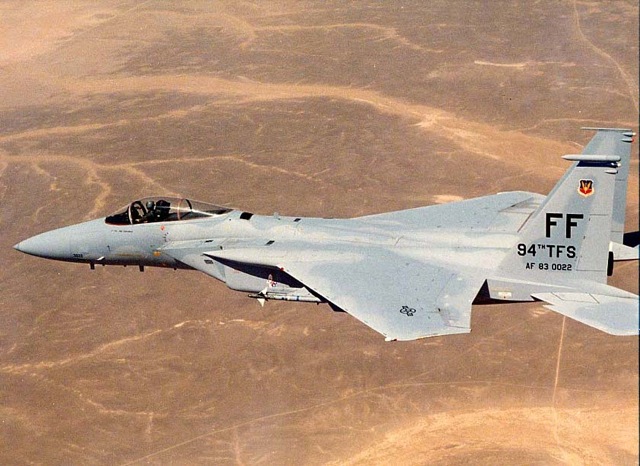By Stephen Chapis
“After a few minutes of waiting, Colonel Chuck Holden called me into his office. He was in a flight suit with his feet up on his desk and a cigarette dangling out of the corner of his mouth. I saluted and as he returned a half-ass salute he leaned forward and shook a piece of paper at me. He growled, ‘Z-man. How the [expletive] did you get this job?’ I replied, ‘What job would that be, sir?’ He congratulated me as he handed me the paper. It was a letter, on 4477th letterhead, from George Gennin notifying my wing commander that I was being reassigned to the Red Eagles as of October 1983. That’s how I found out I got the job.”
Due in no small part to restrictive, politically imposed rules of engagement, the U.S. Air Force kill ratio during the Vietnam War was just 2.04-to-1. In the 1990s, during operations over the Middle East and the Balkans, Air Force fighter crews scored 50 aerial victories for no losses. This dramatic turnaround is often credited to the advent of the Red Flag in 1975, but it was a number of classified exploitation programs and the establishment of a top-secret squadron that operated MiG-17s, MiG-21s, and MiG-23s that allowed the Air Force to achieve such unchallenged air dominance.
In early 1968, the United States borrowed and exploited the capabilities of an alleged ex-Iraqi MiG-21F-13 Fishbed E under the classified program Have Doughnut. The following year, the U.S. obtained a quartet of MiG-17F Fresco Cs, also alleged to be Iraqi in origin, and exploited those jets under the Have Drill and Have Ferry. In 1973, exploitation programs such as these were formalized under Have Idea, and five years later, the highly classified 4477th Test and Evaluation Squadron (TES) was established at the equally classified Tonopah Test Range, north of Nellis AFB, Nevada.
In a nutshell, the purpose of the Red Eagles was to expose as many pilots as possible to real MiGs, to eliminate what was called “buck fever”, the pilot’s shock of suddenly seeing a real MiG up-close for the first time. It was better for a fighter pilot to get the proverbial deer-in-the-headlights look with a “friendly” MiG over Nevada rather than in combat with a hostile foe.
The program in which the Red Eagles operated was known as Constant Peg, but we’re not here to present the history of the squadron as it is covered in great detail in Steve Davies’ 2008 book, “Red Eagles: America’s Secret MiGs” and “America’s Secret MiG Squadron: The Red Eagles of Project Constant Peg”, which was written by the Red Eagles first commanding officer, Galliard R. Peck, Jr., Col. USAF, (Ret.) in 2014. What follows is the story of Robert J. “Z-Man” Zettel, Lt. Col. (USAF), Ret. (Bandit 39), and his career path that led him to the Red Eagles and the cockpit of the Mikoyan Gurevich MiG-23 Flogger.
Born in Racine, Wisconsin, Robert Zettel grew up in a family where no one had flown or even been in the military. Through his high school years, Zettel read a lot about aviation built model airplanes, and decided that he wanted to be a pilot, but a high school guidance counselor killed that dream. Zettel told the author, “I told him I wanted to be a pilot. I was so naïve that when he asked me what kind, I said, ‘I don’t know. Air Force or Navy.’ I’m sure he meant well, but he gave me three or four reasons why that would never happen and that I should probably think of doing something else. I was completely deflated.” Not even a year later, Zettel’s Air Force career came out of the most unlikely place, “…one of my older brothers was heading for Notre Dame and the ROTC department had sent him a big package. He threw it out because he wasn’t interested, so I literally pulled it out of the garbage. I asked, ‘What’s this?’ He said, ‘Something about Air Force.’ So, I looked through all the colored brochures, and back in the day, they had those little tear-out things, so I filled one out and sent it in.” Zettel related.
That piece of refuse launched Zettel’s career. He took his Air Force test and was awarded a four-year Air Force scholarship at the University of Saint Thomas in Saint Paul, Minnesota. Upon graduation, he received his commission through the Air Force ROTC program and went to an undergraduate pilot training class at Vance Air Force Base (AFB) in Enid, Oklahoma, where he graduated at the top of his class in March 1978. After completing his conversion training in the F-4 at Luke AFB, Arizona he flew F-4Ds with the 12th Tactical Fighter Squadron (TFS)/18th Tactical Fighter Wing (TFW), at Kadena AB, Okinawa followed by F-4Es the 36th TFS Osan AB, Korea, which was the last F-4E unit in the Air Force.
It was during his time at Kadena that Zettel set his sights on becoming an aggressor pilot and his assignment to 36th, which was the last air superiority F-4E unit, was quite beneficial in building his credentials and skill set. Zettel spoke of his path to the Aggressors, “I was first introduced to the Aggressors at Kadena… I looked at their role and thought it was an ideal role to hone my skills and become a real air-to-air expert. When my flight commander offered me the opportunity to go to F-4 Weapons School, I turned it down because I wanted to be an Aggressor. He was a graduate of that school and my response to his offer was simply, ‘Well, thanks I’d rather be an Aggressor.’ He was livid.”
Zettel called the commander of the 26th Tactical Fighter Training Squadron (TFTS), which was based at Clark AB, Philippines, that afternoon and told him he’d been offered the weapons school slot, but he’d rather be an Aggressor and amazingly after asking Zettel how much time he had (he had 600 hours in F-4), he hired him on the spot. When he completed his tour at Osan in September 1981, Zettel went to Nellis to check out in the F-5E and complete the Aggressor Program, which included a single surreal sortie against a mysterious MiG-21 and reported to the 26th at Clark in February 1982.
When Zettel came home for Christmas in December 1982, he spent a few days at Nellis and had a most fortuitous meeting with a friend from Clark, “I happened to run into a guy by the name of Jim Day. He’d been one of our GCI controllers at the 26th and was then working GCI for the 4477th. When he saw me in the hallway at the 65th he asked, ‘What are you doing here?’ I said, ‘Well, I’m home on Christmas leave, so I’m hanging around for a day or two to see some old friends and talk to the commander.’ He looked at me and said, ‘Do you have your Class A uniform with you?’ I said, ‘Yes. Why?’ He said, ‘Your name has been floating around as a possible Red Eagle.’ I was shocked because I didn’t think I could get there from where I was in my career at that time.” Zettel recalled.
Day arranged for Zettel to meet with Lieutenant Colonel (LTC) George S. Gennin, who was the Red Eagles commanding officer at the time. Zettel recalled the interview in 2016, “I walked in, saluted smartly, and introduced myself. I think they already knew who I was. Gennin asked me, ‘Would you have any problems flying these airplanes? These are not your standard airplanes. They’re not as safe. We’ve had accidents. We’ve had people get killed.’ Of course, I was young and single, so my reply was, ‘Absolutely. No problem.’ You throw caution to the wind, and you’re bulletproof at that age, right? Anyway, it was all over in 35 or 40 minutes, and I still remember as I was walking out the door he said, ‘Don’t call us, we’ll call you.’ Well, at that point I figured I’d never get the job.”
Three months after Col. Holden handed Zettel the letter from LTC Gennin, Zettel arrived at Nellis in September 1983 to begin a most amazing time in his career. He told the author in August 2021, that the cover story was that he was flying “highly modified F-5s” at a secret location north of Las Vegas. Over the years, this cover story was bolstered when Z-Man would go on the road with the 65th. Zettel arrived when the Red Eagles were in a period of transition as they had just retired the MiG-17s and received a number of MiG-23s.
A total of 61 Air Force, Navy, and Marine Corps pilots were assigned to the 4477th during its 11-year existence and nearly half logged time in the Flogger. There could have been more, but there were some who turned down the opportunity to check out in the swing-wing fighter, especially after crashes claimed the lives of Capt. Mark “Toast” Postai (Bandit 25) and Lieutenant General Robert M. “Bobby” Bond in 1982 and 1984 respectively. Zettel on the other hand made it known that he would jump at the chance to fly the jet and after two years and 338 sorties in the MiG-21, he got his chance.
Zettel explained the process of learning to fly the MiG-23 without the benefit of a two-seat trainer, “The checkout was very similar to the 21. I sat down with the squadron IP (Instructor Pilot) for a few days of academics, which included sitting in the airplane, touching all the buttons and switches, and spending a lot of time on emergency procedures. Then one morning you go out there, crank the airplane do a taxi out to the end of the runway, and then come back. Then in the afternoon, you do the same thing again, except this time you go out to the runway, close the canopy, light the afterburner, pull it out quickly, pop the drag chute, exit, and drop the chute off in the infield and taxi back to the ramp. You didn’t take your checkride until the fourth or fifth hop.” On those early flights, the pilot in the MiG had an experienced Red Eagle on his wing in a T-38.
Once Z-Man was fully checked out in the MiG-23, he began flying presentation flights in earnest, and despite its dubious reputation, Zettel loved flying “the 23”, he was especially impressed with its speed and described two flights where, as Sam Shepard said in ‘The Right Stuff’, he wanted “…to see where that old demon lives.” Zettel told the author, “Once I was down on the deck at two or three hundred feet… and I indicated 830 knots, which was probably close to 1.4 Mach. It was really moving.”
The second flight was a functional control check flight, a favorite of fighter pilots because the airframe is unencumbered by pylons, missile rails, and external tanks. Zettel said, “That was on the deck. I once did a functional check flight, and I had some extra fuel. I was talking to the GCI controller, and he said the ranges were clear. So, I thought to myself, ‘You know, I’m going to see what this thing will really do.’ I climbed to 40,000 feet and did a straight and level 1G acceleration. If I recall the [canopy] redline was 2.23 [Mach] and when I hit 2.2 it was still going, and I thought, ‘That’s close [to redline], that’s fast enough.’ The MiG-23 was the fastest jet I ever flew.”
Whereas the MiG-21 was a dogfighter with an excellent turn rate, the MiG-23 Zettel said was “…more of an interceptor than it was a dogfighter… go into a furball… one or two turns and you’re done.”
That statement didn’t keep Z-Man from nearly getting a gun kill against what is today a fighter that is undefeated in aerial combat- the F-15 Eagle. Zettel related the story with a grin, “I obviously had a lot of air-to-air experience, so I learned how to max perform the 23, meaning taking it right up to the angle of attack limit. I would surprise guys by going into the vertical. I would do an attack on them, and they would get ready to reverse… I’d see this turn; I would just take it up… to work them in the vertical. They weren’t used to seeing that. I did that vertical setup with an F-15, and when he reversed early, and I took it up high, and he reversed back, which depleted a lot of his energy. By the time he tried to come back for me, I was up over the top, getting ready to come down as he started to fall off. So, I’m coming down on him… ready to call guns killed and he calls knock it off. I still remember swearing inside my oxygen mask, ‘Son of a bitch. I can’t believe you called.’ I’m pretty sure he called knock it off only because he did not want to be the only F-15 guy ever to be killed by a MiG-23.”
By the time he left the 4477th, Zettel had logged 138 sorites in the MiG-23 for a total of 70 hours. After his Red Eagles assignment, Zettel went on F-15 with 94th TFS/1st TFW at Langley AFB, Virginia, and retired in 2001 after 14 years of active duty and six in the reserves. In 1991, he was hired by United where he flew DC-10s, A320s, 767s, and 777s. He retired in 2019 as a 767 Line Standards Manager. Today, he and his wife, a retired Captain for American, reside in Florida and enjoy flying a float-equipped AirCam.
In 2019, Zettel was traveling through the Midwest and stopped at the National Museum of the US Air Force (NMUSAF) to take a brief trip back in time. He was there just as the museum was opening and knew just where to go to see an old friend — MiG-23MS ‘Bort 39.’ Having arrived at the display within minutes of opening, he found no visitors nearby, just a couple of tour guides no doubt wondering why someone was there to see a MiG-23 first thing in the morning. Noticing their curiosity, Zettel explained his background, affiliation to the Red Eagles, and this actual aircraft. The guides said they’d never met anyone who’d actually flown a MiG, much less the one right before them. Without hesitation, Zettel quickly told them a few anecdotal stories about the unit, as well as the aircraft. He then offered to tell them a few more if they would allow him behind the display rope for some photos with his old comrade. They both nodded instantly, and Bandit 39 was soon beside the “Flogger” he’d first flown more than 30 years earlier but couldn’t talk about until just 15 years ago. Oh, and true to his word he told them of a couple of short experiences he and others had in the “Floggers” of the 4477th — a once-top-secret unit that contributed to America’s decades of air dominance.







